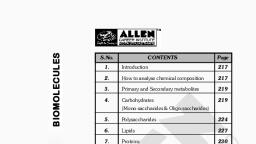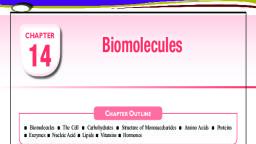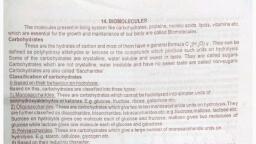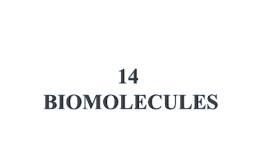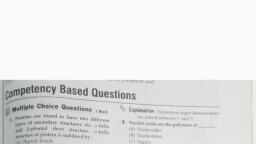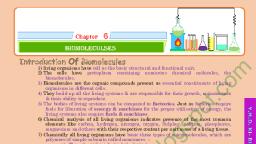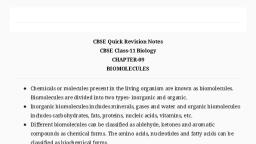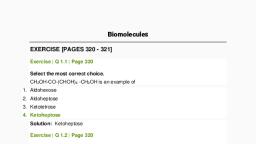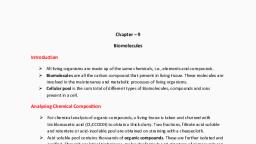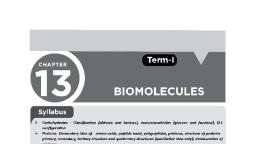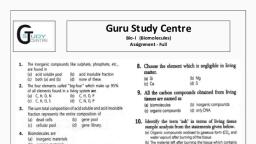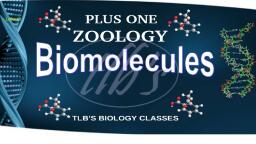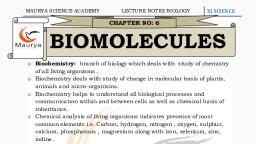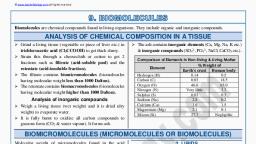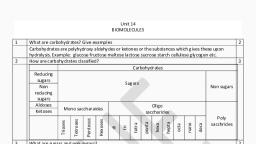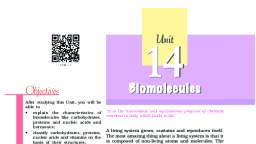Page 2 :
CARBOHYDRATES, Polyhydroxy aldehydes or polyhydroxy ketones or compounds which on hydrolysis give polyhydroxy aldehydes or polyhydroxy ketones are called carbohydrates., Examples 1. glucose – a pentahydroxy aldehyde, 2. fructose – a pentahydroxy ketone, 3. sucrose – gives glucose and fructose on hydrolysis, 4.maltose – gives glucose on hydrolysis, 5. lactose – gives glucose and galactose on hydrolysis, 6. starch – gives glucose on hydrolysis, 7. cellulose – gives glucose on hydrolysis
Page 3 :
CLASSIFICATION OF CARBOHYDRATES, A . On the basis of hydrolysis, On the basis of hydrolysis carbohydrates are classified into three categories, 1. Monosaccharides, 2. Oligosaccharides, 3. Polysaccharides
Page 5 :
CLASSIFICATION OF CARBOHYDRATES, 2. Oligosaccharides, Carbohydrates which give two to ten Monosaccharide molecules on hydrolysis are called oligosaccharides., They are further classified as:, Disaccharides., Carbohydrates which on hydrolysis give two molecules of same or different monosaccharides are called disaccharides , Examples 1. sucrose – gives one unit of glucose and one unit of fructose on hydrolysis, 2. maltose – gives 2 molecules of glucose on hydrolysis, 3. lactose – gives one unit of glucose and one unit of galactose on hydrolysis
Page 6 :
CLASSIFICATION OF CARBOHYDRATES, ii) Trisaccharides – give three molecules of same or different monosaccharides on hydrolysis. , Example – raffinose (C18H32O16) gives glucose, fructose and galactose on hydrolysis , 3. Polysaccharides , Carbohydrates which on hydrolysis give large number of monosaccharide molecules are called Polysaccharides., Examples 1. Starch – a polymer of α-glucose which on hydrolysis gives large number of glucose molecules, 2. Cellulose – a polymer of β-glucose which on hydrolysis gives large number of glucose molecules.
Page 7 :
CLASSIFICATION OF CARBOHYDRATES�B. On the basis of Taste, Sugars, Sweet in taste , Crystalline in nature , Soluble in water, Eg . Glucose, fructose, sucrose, Non-sugars, Tasteless , Amorphous in nature, Insoluble in water , Eg. Starch, cellulose, glycogen
Page 8 :
CLASSIFICATION OF CARBOHYDRATES�C. On the basis of Reducing Behaviour., Reducing sugars, Carbohydrates which are capable of reducing Tollen’s reagent and Fehling’s solution are called reducing sugars., Eg. Glucose, fructose, lactose, maltose etc., All monosaccharides and disaccharides except sucrose are reducing sugars., Non-reducing sugars, Carbohydrates which are unable to reduce Tollen’s reagent and Fehling’s solution are called non-reducing sugars, Eg; sucrose, Starch, cellulose and glycogen also do not reduce Tollen’s reagent and Fehling’s solution.
Page 12 :
D and L CONFIGURATION, A molecule is assigned D- configuration, if the -OH group attached to the carbon atom adjacent to the –CH2OH(last chiral carbon atom) group is on the right hand side ., On the other hand a molecule is assigned L- configuration, if the -OH group attached to the carbon atom adjacent to the –CH2OH(last chiral carbon atom) group is on the left hand side.
Page 13 :
D and L CONFIGURATION, Most of the naturally occurring sugars are of D-configuration., D and L do not represent dextro rotatory or laevo rotatory, The carbon atom of an aldose is numbered from the –CHO group and that of ketose is numbered from that end which is closest to the ketonic group. , Monosaccharide molecules contain one or more chiral/asymmetric carbon atoms and therefore they are optically active.
Page 14 :
GLUCOSE – C6H12O6 Grape sugar, Glucose is an aldohexose. , Glucose correctly named D(+)glucose. D represents configuration and + represents dextro rotatory. Therefore it is also known as dextrose. , Starch, cellulose and glycogen are polymers of glucose., It has an aldehyde group, one primary alcoholic group and four secondary alcoholic groups.
Page 15 :
This structure of glucose was assigned on the basis of following evidences.�1. Heating with HI�When heated with hydroiodic acid and red phosphorus, forms n-hexane. This indicates that all the six carbon atoms are linked in a straight line.
Page 16 :
2. Reaction with hydroxyl amine, Glucose react with hydroxyl amine form glucose oxime. This indicates the presence of a carbonyl group(>C=O) , , , , 3. Reaction with bromine water., Bromine water oxidises glucose to gluconic acid. This indicates that carbonyl group present is –CHO group.
Page 17 :
4.Reaction with acetic anhydride, Glucose react with acetic anhydride in the presence of anhydrous ZnCl2 , to form glucose pentaacetate/penta acetyl glucose. This indicates the presence of five –OH groups in glucose molecule., , , , 5. Reaction with Nitric acid. Nitric acid oxidises glucose to saccharic acid/glucaric acid. This indicates the presence of a primary alcoholic group in glucose.
Page 18 :
Chemical test to differentiate between glucose and fructose, When glucose is oxidized with bromine water gluconic acid is formed. In this reaction red/reddish brown colour of bromine water disappears. Fructose does not react with bromine water . Thus glucose decolourises bromine water, fructose does not.
Page 19 :
FRUCTOSE – FRUIT SUGAR –C6H12O6, Fructose contains a keto(>C=O) group at C2 position, It has six carbon atoms arranged in a straight chain as in case of glucose., It belongs to D-series and is laevo rotatory. Therefore it is also called laevulose., Its name is written as D(-) fructose., It is a pentahydroxy ketone., It contains two primary alcoholic group and three secondary alcoholic group.
Page 20 :
AMINO ACIDS AND PROTEINS, AMINO ACIDS, Amino acids are organic compounds containing both amino group(-NH2) and carboxyl group(-COOH). , All naturally occurring amino acids are α-amino acids. ie they contain amino group on α- carbon atom ( carbon next to –COOH group)., α-Amino acids are the building blocks of proteins., All naturally occurring amino acids belong to L-series which have –NH2 group on the left. There are 20 natural amino acids found in proteins., Except glycine, all other α-Amino acids contain asymmetric carbon atom and are optically active., The general structure α-amino acids is given below.
Page 21 :
CLASSIFICATION OF AMINO ACIDS, Depending on the number of amino groups and carboxyl groups amino acids are classified as:, Neutral amino acids – They contain equal number of amino groups and carboxyl groups. Examples: Glycine, valine, alanine etc, Acidic amino acids – They contain more number of carboxyl group than amino groups. Eamples: aspartic acid, glutamic acid and proline., Basic amino acids - They contain more number of amino group than carboxyl groups. Examples: lysine, arginine
Page 22 :
ESSENTIAL AND NON-ESSENTIAL AMINO ACIDS, ESSENTIAL AMINO ACIDS., The amino acids which human body cannot synthesize and must be supplied in the diet are called essential amino acids. Human body can synthesize 10 out of 20 amino acids found in proteins., Examples: Valine, leucine, lysine etc., The lack of essential amino acids in diet can cause diseases such as Kwashiorkor, NON-ESSENTIAL AMINO ACIDS, The amino acids which are synthesized by human body are called non-essential amino acids. We do not require these in our diet, Examples: glycine, alanine, glutamic acid etc.
Page 23 :
Physical properties of amino acids., They are colourless crystalline solids., They are soluble in water and have high melting points., They behave like ionic salts rather than simple amines or carboxylic acids. This is due to the existence of amino acids as zwitter ion/internal salt/dipolar ion., Zwitter ion - Due to the presence of basic amino group and acidic carboxyl group in amino acid molecule, the proton from the carboxyl group is taken up by amino group( internal neutralization) to form a dipolar ion. This is called zwitter ion/internal salt
Page 24 :
Zwitter ion is neutral but contains both positive and negative charges., In amino acids acidic character is due to –NH3+ group and basic character is due to –COO- group. , Acidic and basic character of amino acids according to Zwitterion structure , In acidic solution, the carboxylate ion(–COO-) accepts a proton from acid and gets converted to –COOH group and exist as cation/positive ion., positive ion
Page 25 :
In basic solution –NH3+ of zwitter ion loses a proton in the presence of OH– ion of the base and get converted to –NH2 group and exists as negative ion/anion., , , , , , Thus amino acids exist as positive ion in acidic solution and negative ion basic solution., On passing electric current it will migrate towards the cathode in acidic solution and towards the anode in basic solution., negative ion
Page 26 :
ISOELECTRIC POINT, At a particular pH called isoelectric point, amino acid exists as neutral zwitter ion and does no migrate to either electrode, The pH at which a particular amino acid does not migrate to either electrode under the influence of electric field and exists as a neutral dipolar ion is called isoelectric point., The neutral amino acids have isoelectric points in the range of 5.5 to 6.3. (for example isoelectric point of glycine and alanine is 6.1).
Page 27 :
PEPTIDES, POLYPEPTIDES AND PROTEINS, Peptides. The compounds formed by the condensation of two or more same or different amino acids are called peptides., Peptide bond/ peptide linkage. When two amino acid molecules combine, the carboxyl group of one amino acid condense with amino group of the other amino acid with the elimination of a water molecule. The resulting –CO-NH- linkage is called peptide linkage or peptide bond and the product formed is called dipeptide.
Page 29 :
POLYPEPTIDES and PROTEINS, If a large number of α-amino acids are joined by peptide bonds, the resulting polyamide is called polypeptide., Proteins are actually polypeptides. However there is no clear line of demarcation between polypeptides and proteins, Polypeptides having molecular mass greater than 10000amu are referred to as proteins, Thus proteins are regarded as long polymers of amino acids joined by peptide bonds., Proteins are complex nitrogenous molecules which are essential for the growth and maintenance of life. These perform a wide variety of biological functions.
Page 30 :
CLASSIFICATION OF PROTIENS ON THE BASIS OF MOLECULAR STRUCTURE, GLOBULAR PROTIENS, FIBROUS PROTIENS, This type of proteins consist off linear thread like molecules lie side by side to form fibres., , These are insoluble in water., They are stable towards moderate change in pH and temperature., They are stabilized by strong intermolecular hydrogen bonding., Examples: Myosin, fibroin, collagen, keratin etc., in this type of proteins, polypeptide chains are folded in such a way as to give spheroidal shape to the protein molecule., These are soluble in water., They are very sensitive towards changes in temperature and pH., They are stabilized by comparatively weak hydrogen bonding., Examples: haemoglobin, albumin, hormones, enzymes, etc.
Page 31 :
Denaturation of Proteins, The process that changes the physical and biological properties of proteins without affecting the chemical composition of protein is called denaturation., Denaturation is caused by 1) changes in pH( by adding concentrated acids), 2) change in temperature ( by heating), 3) addition of heavy metal salts such as HgCl2, AgNO3 etc, 4) adding alcohol, 5) radiations such as x-rays or ultraviolet rays., Proteins lose their biological activity on denaturation., Denaturation is generally irreversible., During denaturation globular proteins becomes fibrous., Denaturation does not change the primary structure (sequence of amino acids). It changes secondary and tertiary structure (arrangement of polypeptide chains and overall shape)of proteins., Examples of denaturation: 1) boiling of egg 2) curdling of milk 3) preparation of cheese from milk etc.
Page 32 :
NUCLEIC ACIDS, Nucleic acids are biologically important polymers which are present in all living cells., The monomer unit present in nucleic acids is called nucleotides., Therefore they are known as polynucleotides., There are two types of nucleic acids:, i) DNA - Deoxyribonucleic acid, ii) RNA - Ribonucleic acid.
Page 33 :
Structure of Nucleic acids, A nucleotide consists of three chemical components:, i) a pentose sugar , ii) a heterocyclic nitrogen base , iii) a phosphate group., Pentose Sugar., There are two types of sugars present in nucleic acids., The sugar present in DNA is deoxyribose (β-D-2-deoxyribose) and the sugar present in RNA is ribose (β-D-ribose) , Nitrogen bases., There are two different types of nitrogen bases. These are known as purines and pyrimidines
Page 34 :
Purine bases are: (i) Adenine and (ii) Guanine, Pyrimidine bases are: (i) cytosine (ii) thymine and (iii) uracil, The bases present in DNA are adenine, guanine, cytosine and thymine. (A, G, C, T), The bases present in RNA are adenine, guanine cytosine and uracil. (A, G, C, U), The base which is not present in DNA is uracil , The base which is not present in RNA is thymine., iii) Phosphate group, This group is responsible for linking nucleotides together in a nucleic acid molecule.
Page 35 :
Nucleosides and Nucleotides , Nucleosides. , The Base-sugar unit present in a nucleic acid is called nucleoside., Base + Sugar = nucleoside, Depending upon the type of sugar unit present, nucleosides are of two types. They are i) deoxyribonucleosides(which contains deoxyribose) and ribonucleosides(which contains ribose), Nucleotides., The Base-Sugar-Phosphate unit present in nucleic acid is called nucleotide., Base + Sugar + Phosphate = nucleotide, Depending upon the type of sugar unit present, nucleotides are of two types. They are i) deoxyribonucleotides(which contains deoxyribose) and ribonucleotides(which contains ribose)
Page 36 :
Nucleic acids are polynucleotides., During the formation of nucleic acid molecule, thousands of nucleotides join together to form polynucleotide chains(strands), The nucleic acid back bone consists of alternating sugar-phosphate units. Each sugar unit is attached to a base unit. It can be represented as follows.
Page 37 :
Structure Of DNA (Watson and Crick model), According to James Watson and Francis Crick DNA molecule consists of two right handed helical polynucleotide chains coiled together in the form of a double helix., The two polynucleotide chains(strands) are held together by hydrogen bonds between the bases present on their back bones., The hydrogen bonds are highly specific and are formed between a purine and a pyrimidine base pair., Adenine is linked to thymine with two hydrogen bonds and guanine is linked to cytosine with three hydrogen bonds., Thus the base sequence of one polynucleotide chain automatically fixes the base sequence of the other polynucleotide chain. , Hence the two polynucleotide chains are complimentary to each other.
Page 38 :
Double helix structure of DNA
Page 39 :
Differences Between DNA and RNA, DNA, It has double stranded helix structure., The sugar present is deoxyribose, Nitrogen base uracil is not present., RNA, It has a single stranded helix structure., The sugar present is ribose., Nitrogen base thymine is not present
